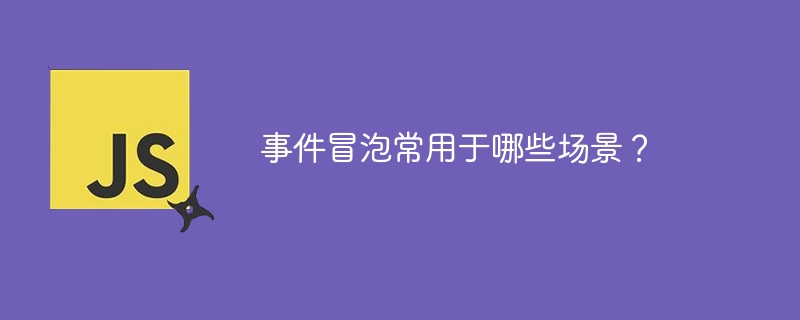Home >Web Front-end >JS Tutorial >What are the application scenarios of event bubbling?
What are the application scenarios of event bubbling?
- PHPzOriginal
- 2024-01-13 08:18:051302browse

What scenarios are event bubbling commonly used in? ——In-depth understanding of the principle of event bubbling and its application
Event bubbling is an event model commonly used in web development. It can simplify the code structure and provide an effective way to handle a large number of similar events. Case. This article will delve into the principle of event bubbling, as well as common scenarios in practical applications, and provide specific code examples to help readers better understand.
The principle of event bubbling means that when an element triggers an event, the event will bubble up from the most specific element to the top-level parent element. In other words, if a parent element also has a listener bound to the event, then when the child element triggers the event, the parent element's listener will also be triggered. The beauty of this bubbling mechanism is that we don't need to write listening functions for each child element separately. We only need to listen for events on the parent element, and we can handle the same event on multiple child elements.
In practical applications, event bubbling can be widely used. The following are some common application scenarios and specific code examples:
- Dynamic element binding event monitoring
Suppose we have a list. When the user clicks on the list item, We need to trigger an event for processing. Using event bubbling, we can bind a listener function only on the parent element of the list to avoid binding a listener function for each list item. The specific code is as follows:
// HTML代码
<ul id="list">
<li>列表项1</li>
<li>列表项2</li>
<li>列表项3</li>
</ul>
// JavaScript代码
const list = document.getElementById('list');
list.addEventListener('click', function(event) {
if (event.target.nodeName === 'LI') {
console.log(event.target.textContent);
}
});- Multi-layer nested element event processing
In a complex UI structure, we may have multiple layers of nested elements, and we need to and handle click events of external elements. Using event bubbling, you can conveniently handle click events on internal and external elements on the parent element. The specific code is as follows:
// HTML代码
<div id="outer">
<div id="inner">点击内部元素</div>
</div>
// JavaScript代码
const outer = document.getElementById('outer');
outer.addEventListener('click', function(event) {
if (event.target.id === 'inner') {
console.log('点击了内部元素');
} else {
console.log('点击了外部元素');
}
});- Event delegation
Event delegation is a technology that delegates specific event processing to the parent element. This technique is often used for dynamically loaded elements or large numbers of similar elements. Event delegation uses the event bubbling mechanism. You only need to bind an event listening function on the parent element to handle events on all child elements. The specific code is as follows:
// HTML代码
<div id="parent">
<button>按钮1</button>
<button>按钮2</button>
<button>按钮3</button>
</div>
// JavaScript代码
const parent = document.getElementById('parent');
parent.addEventListener('click', function(event) {
if (event.target.nodeName === 'BUTTON') {
console.log(`点击了${event.target.textContent}`);
}
});Through the above examples, we can see the importance and convenience of event bubbling in practical applications. Not only does it streamline the code, it also provides a flexible way to handle a large number of event-like situations. Mastering the principle of event bubbling and applying it flexibly in actual development can improve development efficiency and improve code maintainability.
In summary, event bubbling is often used in scenarios such as dynamic element binding event monitoring, multi-layer nested element event processing, and event delegation. By deeply understanding the principle of event bubbling and combining it with specific code examples, we can better apply the event bubbling mechanism, improve development efficiency, and write more concise and maintainable code.
The above is the detailed content of What are the application scenarios of event bubbling?. For more information, please follow other related articles on the PHP Chinese website!
Related articles
See more- Detailed explanation of event bubbling and event capturing examples
- js prevents default events and js prevents event bubbling examples to share js prevents bubbling events
- Introduction to bit operations and application scenarios in java
- Learn about watchEffect in Vue3 in one article and talk about its application scenarios!
- What is event bubbling

